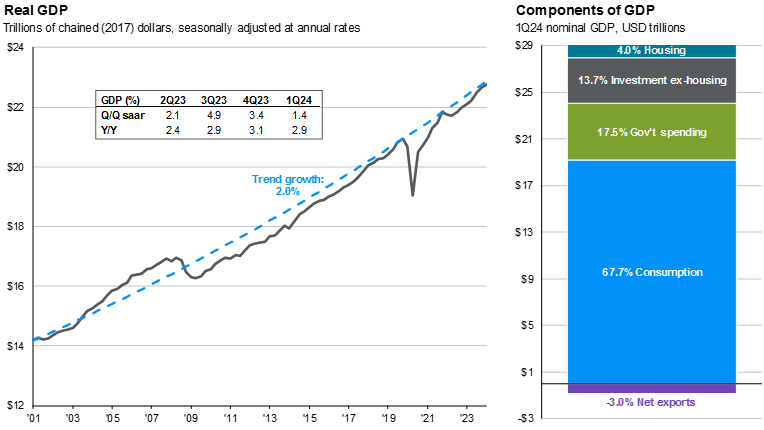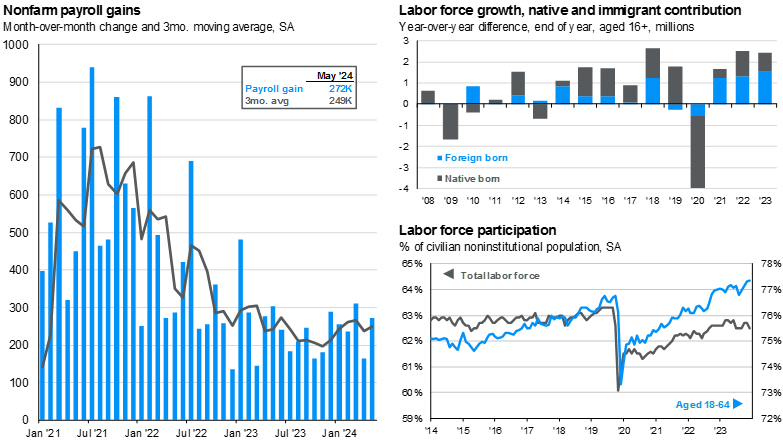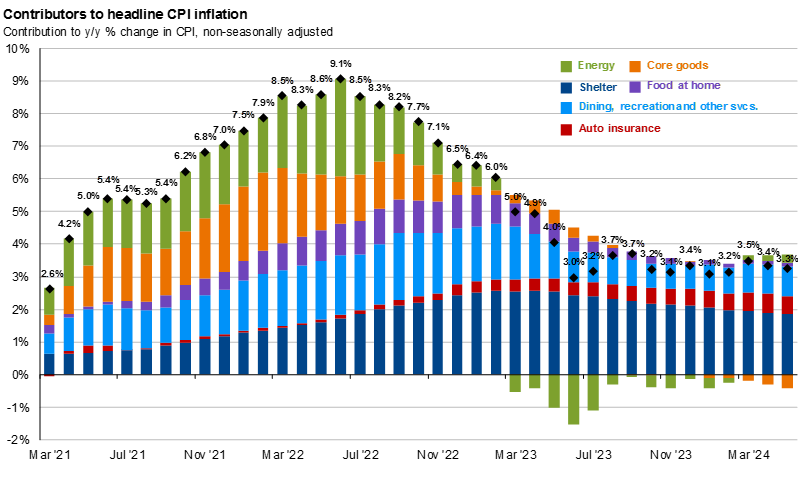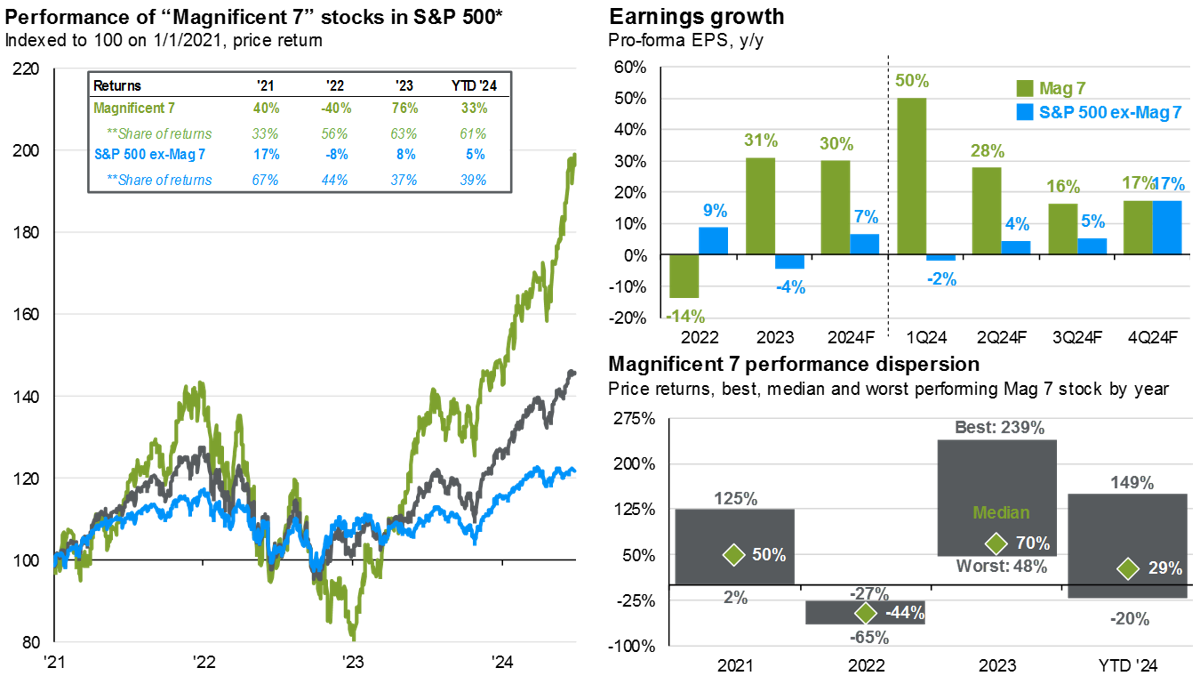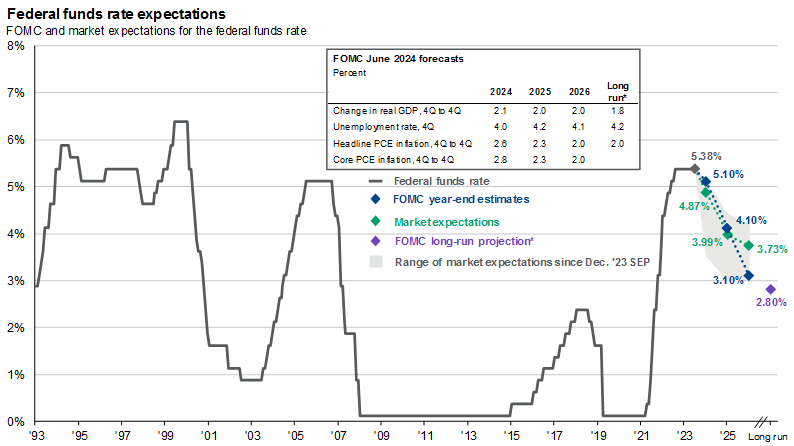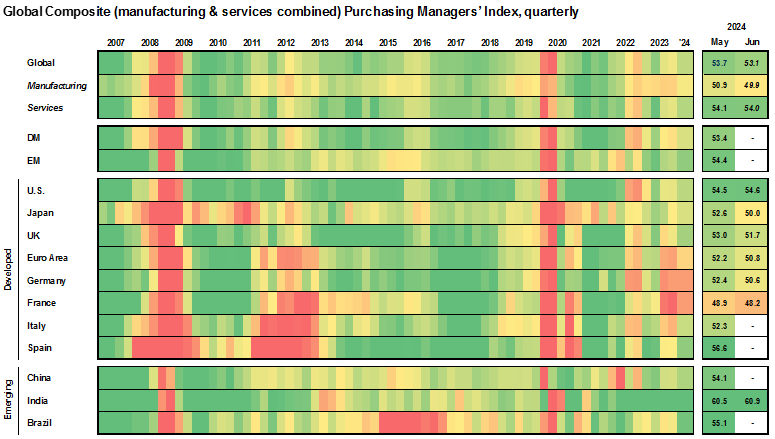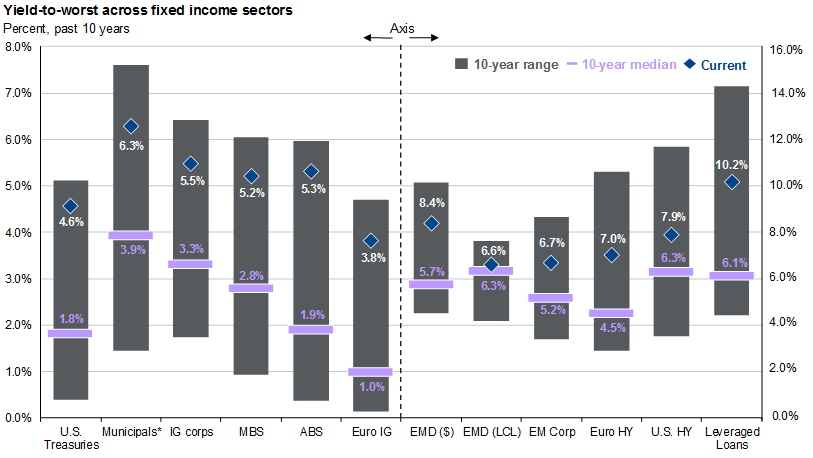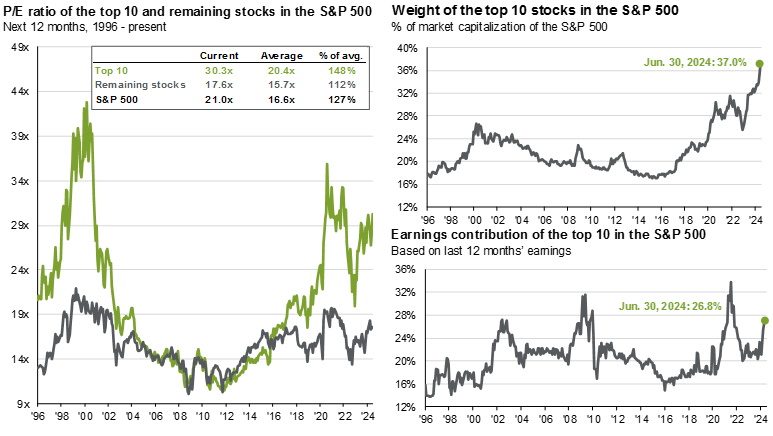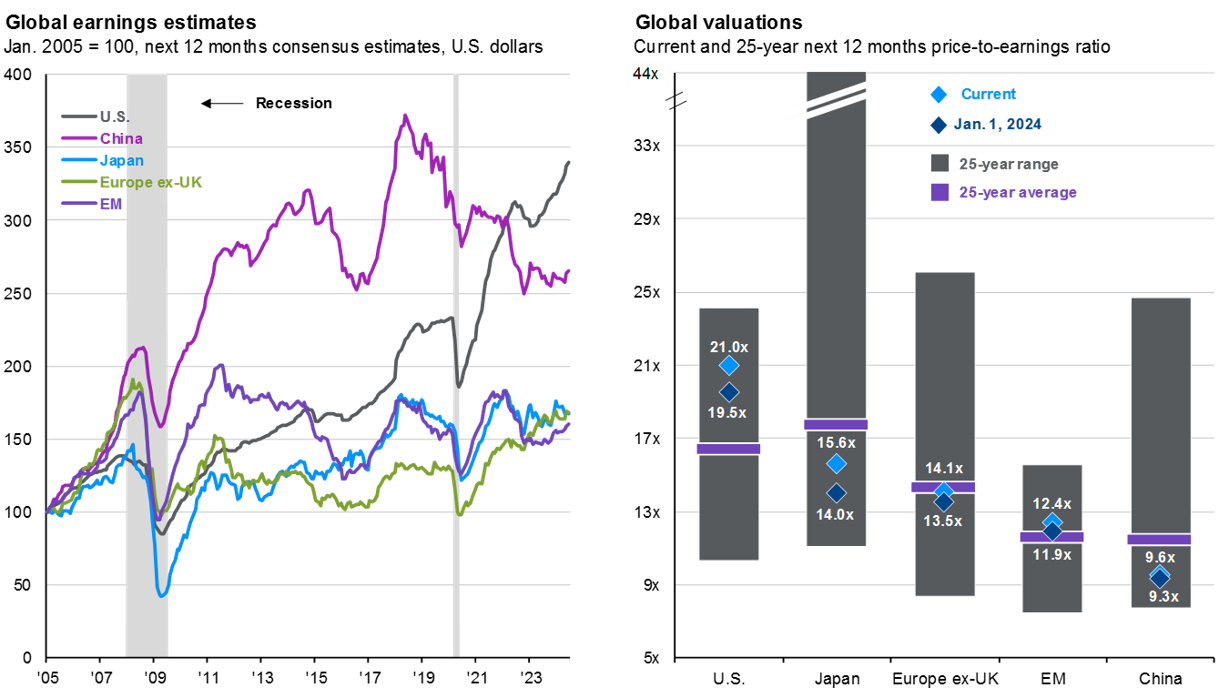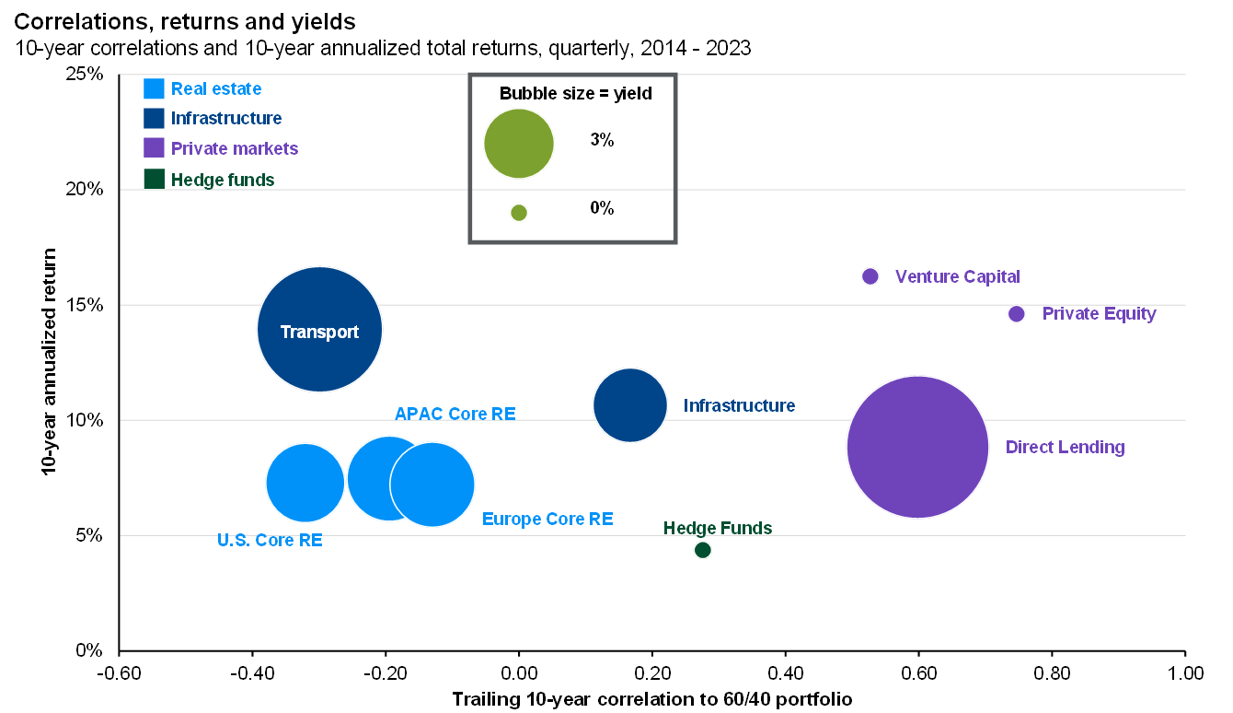3Q24 Economic and Market Update
This is David Kelly.
I’m Chief Strategist here at J.P. Morgan Asset Management and I head the team that produces the Guide to the Markets. Welcome to the Economic and Market Update for the second quarter of 2024.
Despite facing numerous challenges in 2023, the U.S. economy defied widespread predictions of recession. Growth moderated to a still-strong 3.2% pace in the fourth quarter while inflation continued to fall towards the Fed’s 2% target, although progress has slowed in recent months. This year, moderate job gains and easing inflation should allow the U.S. economy to continue on a soft-landing path. That said, as cyclical tailwinds fade and the U.S. election approaches, there are still plenty of risks to economic stability.
Meanwhile, while the Federal Reserve held rates steady its March meeting, the Fed’s updated dot plot showed only the smallest possible majority of FOMC members expecting as many as three rate cuts in 2024, and they reduced the number of expected rate cuts in 2025 from four to three, underscoring the very gradual nature of projected policy easing. On a more positive note, they did express their intention to begin to reduce quantitative tightening fairly soon.
As investors adjusted to the prospect of fewer rate cuts, long-term interest rates moved higher during the first quarter. Equities, however, appeared unphased by this, setting new all-time highs with the largest stocks still leading the charge. In the year ahead, attractive relative fundamentals outside of the largest stocks should support broader equity market performance, while fixed income should play its traditional role of providing income and diversification. Outside of public assets, alternatives still offer investors to enhance portfolio performance through alpha, diversification and income.
The Guide to the Markets, now in its 20th year, is constructed to try to illustrate economic fundamentals and investment opportunities and risks. However, it is important to do this concisely. There are over 60 pages in the Guide, but that is far too many for any conversation about the markets.
So, what we do here is boil it down to just 11 slides. In particular, we assess the recent performance of the markets and economy, considering trends in growth, jobs and inflation in the U.S., and how these trends are shaping the outlook for monetary policy. This is followed by comments on growth from around the globe. Finally, we consider the implications of all of this for those investing across asset classes and highlight the importance stepping out of cash and actively engaging with opportunities in alternative assets.
The U.S. economy ended 2023 on a high note, with the fourth quarter marking the sixth consecutive quarter of growth at or above 2%. While the economy may struggle to match last year’s impressive performance, 2024 looks set to be another year of expansion.
Consumers have displayed impressive strength, supported by a tight labor market. That said, some signs of stress are emerging. While revolving credit as a share of disposable income is not flashing any warning signs, auto and credit card loan delinquencies have risen above their pre-pandemic levels, with student loan delinquencies likely to follow. As a still tight labor market and rising real wages offset dwindling excess savings and tighter credit conditions, consumers should continue to spend at a more moderate pace this year.
Business spending has endured tighter lending standards better than expected, supported by increased spending on intellectual property with greater emphasis on developing artificial intelligence capabilities. Tailwinds from AI spending and support from the federal government should continue to partially offset the impact of higher interest rates, while inventories should continue to grow at a steady pace. However, tighter lending standards and weaker corporate profits could still constrain growth in capital expenditures.
The housing market has stabilized at depressed levels, and while a boom in the sector seems unlikely given elevated mortgage rates, tight supply suggests a recovery in activity is more likely than another decline. Trade may be a slight drag on the economy as a still-strong dollar and sluggish global growth weigh on exports. Meanwhile, increased spending on public infrastructure and stronger hiring should continue to support government spending.
Overall, the U.S. economy remains on a soft-landing track, although last year’s momentum looks set to fade. That said, with a U.S. election on the horizon, high policy rates, and elevated geopolitical tension, risks remain that could knock the U.S. economy off its steady path.
While the labor market has normalized from its post-pandemic boom, the U.S. economy still added an impressive 250,000 jobs per month in 2023 and has sustained this pace into early 2024. This has occurred even as the unemployment rate has remained at or below 4% since December 2022 – the longest such streak of low unemployment since the late 1960s. Despite fears of an economic slowdown, strong growth in the U.S. labor supply has allowed employers to steadily hire workers and narrow the gap between supply and demand.
After falling sharply during the pandemic, labor supply in the U.S. staged an impressive recovery over the last two years, largely due to increased immigration. In fact, in fiscal year 2023, Immigration Services approved over 2 million applications for employment authorization, a 70% increase from a record 1.2 million in fiscal 2022. With this surge in migrant workers, employers were able to fill open job openings without applying upwards pressure to wages, helping to explain why strong job creation hasn’t sparked higher inflation. Importantly, a strong recovery in the labor force participation rate has also boosted labor supply. While continued aging of baby boomers into their retirement years has left the overall labor force participation rate below pre-pandemic levels, participation amongst the working age population, or those aged 18-64, has fully recovered its pandemic losses.
Moving forward, still elevated job openings and moderate economic growth point to steady job gains ahead. While this would seem to imply a steady decline in the unemployment rate, the continued influx of migrants should provide a fresh source of workers which could keep the unemployment rate within a narrow range of 3.5% to 4.0%.
While year-over-year CPI inflation remains well below its June 2022 peak of 9.1%, it has stubbornly hovered around 3.2% since October, sparking fears of no further meaningful decline However, we believe that there are still disinflationary forces that should keep inflation on its downward path this year.
Core goods prices trended lower in 2023 as supply chain distortions related to the pandemic and Russia’s invasion of Ukraine continued to fade. Even with recent conflict in the Middle East, supply chains are still in good shape, and goods prices should remain well behaved. On the more volatile components, energy prices have risen in recent months while food prices continue to ease. Moving forward, slow global demand limits the likelihood of a surge in either of these categories. Lastly, shelter inflation, which accounts for over a third of the CPI basket, should follow real-time measures of market rent increases lower.
That leaves us with core services prices excluding housing, a closely watched measure by the Fed given its ties to the labor market. As we show on the right-hand slide of slide 27, progress here has stalled in recent months, largely due to “transportation services,” which remains elevated due to things like auto insurance and repair costs. However, as the rollover in vehicle and auto prices feed through the data, pressures here should ease substantially. This, along with moderating wage growth, should allow services prices to trend lower through the end of the year.
Overall, the disinflationary trend established in 2023 should continue into 2024. While the ride down may take slightly longer than anticipated, the Fed should feel reasonably confident that inflation can fall to close to their 2% target by the end of the year.
With the fourth quarter earnings season in the books, earnings growth finished 2023 flat despite a year of above average economic activity. While these are seemingly lackluster results, they actually surpassed initial expectations for a small earnings contraction. Robust economic activity supported revenues, which were the largest contributor to earnings growth, as consumer strength and pricing power helped boost sales. Margins, however, have detracted from earnings as higher wages, inflation in input costs and geopolitical turmoil offset some of the costs savings of adapting more efficient technological processes. This dynamic was evident in the fourth quarter as margins fell after a third quarter recovery.
While profits could experience healthy growth in 2024, downside risks to analyst expectations for double-digit earnings growth remain. Indeed, gloomy commentary from management teams point to tougher times ahead as growing revenues will become increasingly difficult in an environment of moderating consumer demand and disinflation. However, after the “Magnificent 7” companies drove the lion share of earnings growth in 2023, profit leadership should broaden out this year.
Late last year, the Federal Reserve sparked investor enthusiasm for aggressive policy easing in 2024 after they signaled that rates are at their cycle peak. Since then, mixed economic data has challenged investors’ outlook for rate cuts and left them searching for more guidance.
At its March meeting, the Federal Reserve left rates unchanged at a range of 5.25% to 5.50% and continued to signal three rates cuts in 2024. However, they cut their forecast for rate cuts in 2025 from four cuts to three. In addition, they boosted their projection for the federal funds rate in the long run from 2.5% to 2.6%, in a sign of a slightly more hawkish stance.
In addition, to rate cuts the Fed signaled that they plan to slow the pace of quantitative tightening fairly soon. This should leave the Fed with much larger Treasury holdings that before the pandemic for an extended period of time, helping hold long-term interest rates down. With market expectations and Fed messaging very much in sync, it would likely take a meaningful change in the economic outlook to trigger any sharp movement in long-term interest rates in the months ahead.
The international economy ended 2023 on a rather sluggish note, although there were some exceptions. This dynamic will likely persist into 2024, as some economies could outshine others amidst slowing global momentum.
Depressed sentiment in China continues to challenge both domestic and global growth, and even more economic troubles could lie ahead without meaningful policy support for consumers and manufacturers. Similarly, Europe remains burdened by weaker consumption and business activity, particularly in Germany. However, the prospects of lower energy prices and rising real wages have sparked optimism for improvement ahead. In Japan, the end of negative interest rates should serve as a strong tailwind for activity after the country narrowly avoided a technical recession last year. Other markets, such as Mexico, India and Taiwan have benefited from positive secular trends, including supply chain diversification and semiconductor manufacturing related to AI.
This year could bring better performance for places like Japan and some European markets while others, like China, may continue to struggle. With U.S consumer activity expected to slow, there is still potential for growth differentials to narrow and for other global markets to surprise to the upside.
After hopes for aggressive policy easing fueled an impressive bond market rally late last year, most sectors shown on slide 31 are off to a slower start in 2024 as resilient economic data have forced investors to reign in their expectations for rate cuts. That said, with market and Fed expectations now largely in-line, the worst of bond market volatility is likely behind us, and current yields appear increasingly attractive.
Indeed, with higher yields now offering an attractive “yield cushion,” fixed income offers strong asymmetric returns. Taking the U.S. Aggregate as an example; if yields were to fall by 1%, an investor could expect a return upwards of 11%. However, if rates were to rise by 1%, the coupons from the bonds would help offset some of the price depreciation, and that same investor could expect a loss of only 1.5%.
While rising interest rates led to negative bond returns in 2022, those higher rates today offer investors both positive real income and the portfolio protection provided by the traditional tendency of bonds to rally when stocks falter in the face of economic weakness.
After an impressive 2023, U.S. equities have continued their upward momentum in the early months of 2024. In fact, resilient corporate profits and hopes for policy easing have produced multiple all-time market highs this year. However, market performance remains concentrated as the largest stocks in the index have continued to dominate. While valuations might look stretched, there are still plenty of attractive opportunities outside of this cohort of Mega Cap stocks.
On the left of slide 10, we compare the price-to-earnings ratio of the top 10 stocks in the S&P to that of the broader index. The historically narrow nature of the recent rally has left the top 10 stocks significantly more expensive than the broader index, while the remaining stocks look cheap comparatively and are trading closer to their long-term average.
Indeed, index concentration is not a new phenomenon as the weight of the top 10 stocks in the S&P 500 has been rising since 2016. However, while the top 10 stocks dominated earnings growth last year, their earnings contribution hasn’t kept pace over the long run. With the top 10 stocks now representing a third of the index but only a fourth of the earnings, there appears to be a strong case for investing in the rest of the index.
If economic growth continues at a steady pace in 2024, gains should broaden out beyond the largest names as the market grinds higher. In this environment, an active approach can help identify those companies with high quality earnings and attractive valuations that are being overlooked by the markets.
While many U.S. based investors may feel inclined to focus on opportunities at home, there are attractive fundamental tailwinds emerging outside of the U.S. that can’t be ignored. Slide 46 of the Guide aims to highlight opportunities that investors may be missing.
In terms of earnings growth, the U.S. has been the standout market as of late, although prospects in other countries are improving. In particular, higher inflation in Japan and Europe has allowed companies to raise prices and expand their margins, and the end of negative interest rates in both countries should help boost profits for Financials, a key sector in both markets. While pessimism around China has weighed on Emerging Market earnings estimates, they have stabilized in recent months, suggesting that the worst of this pessimism is already priced in.
With the exception of China, strong equity returns since the beginning of 2023 have pushed valuations higher. Even still, in both absolute terms and relative to their own histories, international markets continue to look attractively priced compared to the U.S. Overall, the potential shift in earnings growth across international markets, combined with discounted valuations, presents an attractive opportunity for U.S. investors looking to diversify abroad.
With equity valuations elevated and bond yields low relative to history, less impressive returns from the 60/40 portfolio moving forward may force investors to look elsewhere for consistent outcomes across alpha, income and diversification. However, investors willing to venture outside of the public markets can leverage a range of different alternative assets to reach their desired outcomes. Indeed, as we show on slide 55 of the Guide, alternative assets can offer low correlations to public markets, diversified income streams and enhanced long-run returns.
Real assets shown towards the left, such as real estate, infrastructure and transport, tend to be less correlated to a traditional 60/40 portfolio while providing robust income. Private equity and venture capital, towards the right, provide much higher total returns but come with higher correlations to public markets and less income generation.
The classic 60/40 stock-bond portfolio still looks attractive, but adding a sleeve of alternatives can help long-term investors achieve strategic goals through higher alpha, better diversification and enhanced income.
Thanks to the Federal Reserve’s rate hiking campaign, cash looks more attractive today than in the last two decades. With yields north of 5% and minimal risk, many investors have decided to allocate more heavily to cash, pushing money market fund assets to a record $6.1 trillion.
However, history shows that staying parked in cash after the peak in interest rates usually leaves money on the table. In the last six rate hiking cycles, the U.S. Aggregate Bond Index outperformed cash over each of the 12-month periods following the peak in CD rates, while the S&P 500 and a 60/40 stock-bond portfolio outperformed in 5 of these periods.
This is not to say that investors should abandon cash altogether, as liquidity is an important allocation in any portfolio. However, there is an opportunity cost in holding onto too much cash, and investors should put long-term money in long-term assets. Following a peak in interest rates there has always been a better asset than cash to deploy capital.
This remains the case today, as the U.S. and global economies continue to grow even as inflation wanes and central banks begin to back off from very tight monetary policy. However, with the higher valuations produced by the strong investment returns of 2023 and early 2024, it is more important than ever that investors maintain well-diversified portfolios designed to reduce risk as well as provide solid long-term income and capital gains.
For more on the Guide to the Markets, visit our website at am.jpmorgan.com.
Economic & Market Update: Using the Guide to the Markets to explain the investment environment
